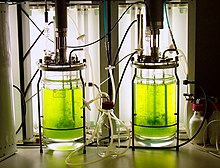Green biotechnology
The Green biotechnology is the branch of biotechnology that deals with the plants (plant biotechnology). Green biotechnology makes use of modern methods of biochemistry , systems biology , microbiology , molecular biology and process engineering to improve crops , extract plant ingredients (phytochemicals, secondary metabolites ) or fibers or to develop plant enzymes or active principles ( bionics ) for new areas of application. The transitions to the other branches of biotechnology are now fluid. Plant cells or enzymes can be used for the production of industrial substances ( white biotechnology ) or drugs (red biotechnology or pharmaceutical biotechnology ). Plants are also suitable for detoxifying soils ( phytoremediation ) or as environmental sensors, which represents a point of contact with gray or brown biotechnology .
Methods
In modern green biotechnology, the Agrobacterium -mediated gene transfer from plasmids is an important technology. With this method of green genetic engineering , individual hereditary factors ( genes ) are transferred from cells of one organism to cells of another living being. It was developed by Jozef Schell at the Max Planck Institute for Breeding Research , among others .
The somatic hybridization (including protoplast fusion or cell fusion called), another important method allows to combine desired features by merging different parent plants. In comparison to the Agrobacterium -mediated gene transfer, no specific genes have to be identified and isolated. In addition, this overcomes the restriction of gene transfer by vectors, namely that only a few genes can be introduced into a given genetic material. The number of chromosomes in the cells can also be multiplied during cell fusion , i.e. the number of chromosome sets ( degree of ploidy ) can be increased. This can increase the productivity of plants ( heterosis effect ). Molecular markers and biochemical analyzes are used to make the work of classic plant breeders easier, and thus to come to new plant varieties more specifically and more quickly , a form of precision breeding also known as “smart breeding”. It is used by many seed breeding companies and horticultural plant nurseries. Such mostly medium-sized companies are organized in the Federal Association of German Plant Breeders.
In addition to these techniques, which are used to optimize plant breeding, other biotechnological methods are increasingly being used. The use of vegetable enzymes in chemical production processes can reduce the consumption of raw materials and energy. In molecular pharming , biopharmaceuticals such as monoclonal antibodies , so-called “plantibodies”, and other valuable substances are produced in so-called pharmaceutical plants . These can be used in diagnostics but also for therapy, e.g. B. can be used in the fight against cancer. The aim of this work is to find a safe alternative to conventional production systems, such as B. CHO cells develop. GMP conditions are best adhered to when the plants are stored in closed containers, such as B. bioreactors are cultivated. One example of this technology is the moss bioreactor developed by Ralf Reski , a photobioreactor with genetically modified Physcomitrella patens .
The increasing understanding of the plant genome and protein networks ( genomics and proteomics technologies ) as well as developments in the isolation , characterization , production of recombinant proteins and online database evaluations help with these applications .
literature
- JKC Ma, E. Barros, R. Bock, P. Christou, PJ Dale, J. Dix, R. Fischer, J. Irwin, R. Mahoney, M. Pezzotti, S. Schillberg, P. Sparrow, E. Stoger, RM Twyman: Molecular farming for new drugs and vaccines. Current perspectives on the production of pharmaceuticals in transgenic plants. In: The European Union Framework 6 Pharma-Planta Consortium EMBO reports. VOL 6, NO 7, 2005, pp. 593-599.
- M. Van Montagu, Jeff Schell: Steering Agrobacterium-mediated plant gene engineering. In: Trends in Plant Science. 2003, Vol 8, Issue 8, pp. 353-354.
- A. Müller, P. Welters: The green in industrial biotechnology - plants as the key to sustainable chemistry. In: GIT Labor-Fachzeitschrift. 03/2008, pp. 246-249., 2008.
Web links
Individual evidence
- ↑ JP Hernalsteens, H. De Greve, M. Van Montagu, J. Schell: Mutagenesis by insertion of the drug resistance transposon Tn7 applied to the Ti plasmid of Agrobacterium tumefaciens. In: plasmid. (1978), Vol. 1, No. 2, pp. 218-225. PMID 748948 .
- ^ Eva L. Decker, Ralf Reski : Current achievements in the production of complex biopharmaceuticals with moss bioreactor. In: Bioprocess and Biosystems Engineering. 2008, 31, pp. 3-9.
